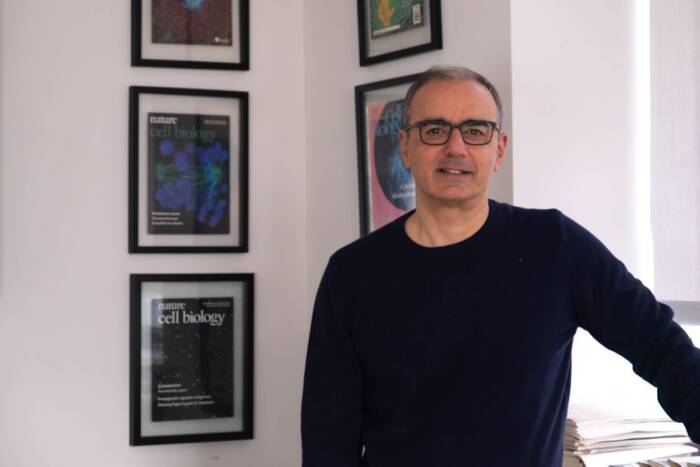To understand the brain, Tessier-Lavigne studies its wiring
It takes several hundred billion nerve cells to put together the human brain, and they must be connected in an intricate and precise pattern in order to function properly. The formation of these connections — the brain’s neural circuits — during an organism’s embryonic development is what ultimately allows the brain to perceive, remember and issue commands to the rest of the body.
Since he first encountered neuroscience as a student at Oxford University, Marc Tessier-Lavigne has been fascinated with the formation of these neural circuits, and he has devoted his scientific career to understanding how nerve cells figure out where to go.
The key to this process of “neuronal guidance” is the axon, a slender extension to the neuron that seeks out and connects to the appropriate set of target cells. The tip of each developing axon contains a specialized sensory structure called the growth cone, which senses chemical guidance cues that instruct it to migrate in a particular direction. Until the early ’90s, that was all anyone knew. But Dr. Tessier-Lavigne’s key discovery — made when he was an assistant professor at the University of California at San Francisco — was that of netrins, a small family of proteins present in the axon’s environment that interact with receptors on the growth cone in order to steer the developing brain cells. The discovery of netrins was published in two Cell papers in August 1994.
Discoveries of other chemoattractive factors involved in neuronal guidance soon followed, and over the years Dr. Tessier-Lavigne’s lab has sought to identify the full complement of cues guiding particular sets of axons, as well as the intracellular pathways they trigger to signal directed motion.

Neurons and netrin. Results from an early neuronal guidance experiment show the growth of long finger-like bundles of axons from neural tissue cultured with netrin (right) compared to tissue grown without. Dr. Tessier-Lavigne published these images in Cell in 1994.
Of course, the story gets more complicated. As an axon progresses along its trajectory, its growth cone exhibits a remarkable plasticity, changing its response to guidance cues — losing responsiveness to those that directed it over the previous leg of its trajectory and acquiring responsiveness to those that will guide it over the next leg. A major focus of Dr. Tessier-Lavigne’s lab in recent years has been on understanding the mechanisms that control this plasticity and switching of growth cone responses, and their relation to other plastic changes, such as those occurring after injury and in learning and memory.
The mechanisms that direct the formation of connections in the embryo also regulate neuronal responses to injury in the adult. While damaged axons in the peripheral nervous system can regrow and regenerate connections, in the central nervous system — the brain and spinal cord — they usually cannot, and paralysis after spinal cord injury is often permanent. Dr. Tessier-Lavigne’s lab has recently found that some of the cues that guide axons in the embryo contribute to blocking regeneration, and that inhibiting their actions can help stimulate repair.
The mechanisms regulating the development of circuits are also relevant to neurodegenerative disease. In the embryo, too many connections are initially formed and many axons have to be eliminated through a process of pruning or developmental degeneration. Dr. Tessier-Lavigne’s lab has shown that several of the cues that initially guide axons are later responsible for triggering axon degeneration in the embryo, and that there are important mechanistic similarities between developmental degeneration and the degeneration that occurs in diseases like Alzheimer’s, providing potential therapeutic entry points for these diseases.


